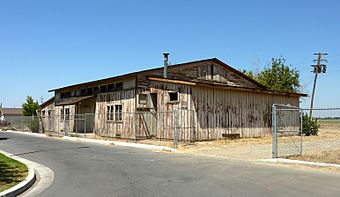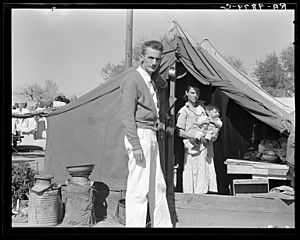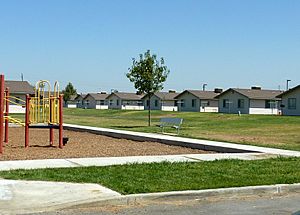Weedpatch Camp facts for kids
Quick facts for kids |
|
|
Weedpatch Camp
|
|

The Community Hall
|
|
| Location | 8701 Sunset Blvd. Bakersfield, California |
|---|---|
| Built | 1936 |
| Architect | Works Progress Administration |
| Architectural style | 20th century vernacular |
| NRHP reference No. | 95001554 |
| Added to NRHP | January 22, 1996 |
Weedpatch Camp is a special place built in 1936 near Bakersfield, California. It was created by the Works Progress Administration (WPA) to help families who moved to California looking for work during the Great Depression. This camp was also known as the Arvin Federal Government Camp or the Sunset Labor Camp. Many of its old buildings are now protected as historic sites on the National Register of Historic Places.
A Place for Migrant Workers
Weedpatch Camp was started because of a big problem in the 1930s. A severe drought hit the middle of the United States, especially Oklahoma. This event is known as the Dust Bowl. Many farmers lost their crops and homes because of the dust storms and dry land.
These families had to leave their farms. They traveled to California, hoping to find work picking crops. Other families came from Texas, Arkansas, and Missouri. When they arrived, they often lived in very poor conditions. Some stayed in "squatter camps," which were just tents set up by the side of the road. Others lived in camps built by farmers, which often lacked clean water or safety.
Government Helps Families
To help these families, the Farm Security Administration (FSA), a government agency, built better camps. These camps had proper buildings, clean running water, and even schools and libraries. The FSA also helped people find jobs. Tom Collins was the first person in charge of Weedpatch Camp.
The U.S. government started programs like the New Deal to help people during the Great Depression. The Works Progress Administration (WPA) built Weedpatch Camp. It was located near the small towns of Arvin and Weedpatch. Today, it is in an area of Kern County that is not part of any town.
The camp first had canvas tents on wooden floors for families to live in. There were also permanent buildings for important community services. These included an office, a community hall, a post office, a library, and a barber shop. Later, the tents were replaced with small wooden houses.
Today, three original buildings from the camp are still standing. These are the community hall, the post office, and the library. The post office and library were moved next to the community hall. This was done to create a historic park on the property. In 2007, the outside of the library and post office buildings were fixed up.
The Camp's Importance
Weedpatch Camp is very important in California's history. It shows how many people moved to the state to escape the Dust Bowl. These migrants were sometimes called "Okies," a term that was often used in a mean way. They faced unfair treatment from some local people.
The famous writer John Steinbeck wrote about the struggles of these families and described Weedpatch Camp in his book The Grapes of Wrath. He even dedicated the book to Tom Collins, the camp administrator, who inspired a character in the story. Another writer, Sonora Babb, worked at the camp with Collins. She wrote a novel called Whose Names Are Unknown about a migrant family from Oklahoma. Her book was not published until 2004.
In 1937, a health expert named Dr. Myrnie Gifford found that some people at the camp had a health issue. This problem was linked to breathing in dust from farm work.
Today, the Kern County Housing Authority manages the camp. It is now called the Sunset Labor Camp. It continues to help migrant farm workers who come to the area for jobs.





